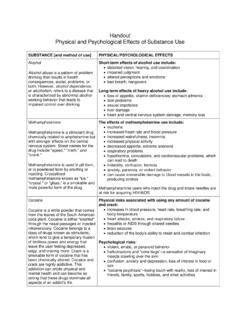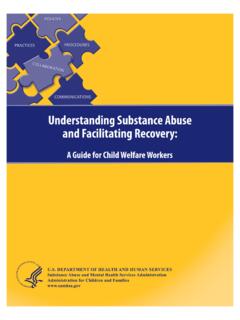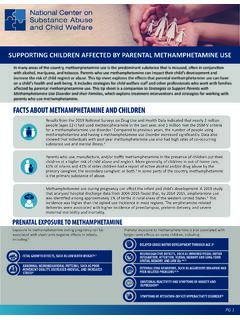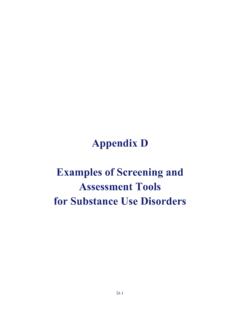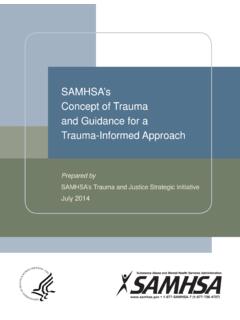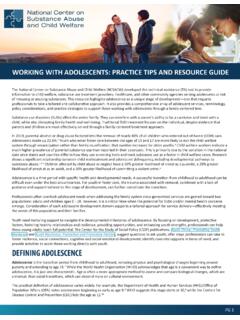Transcription of Understanding Mental Disorders, Treatment, and Recovery ...
1 Module 3. Understanding Mental Disorders, Treatment, and Recovery 1. Mental Disorders - 1. Many terms may be used, such as Mental illness , Mental health problems or behavioral disorders.. Each disorder is different in each person. There is no have it or don't have it . Mental health is a continuum or spectrum. Mental disorders vary from person to person and from time to time. 2. Mental Disorders - 2. Most persons with identified Mental disorders respond positively to treatment. A person cannot catch a Mental disorder from another person, although genetics do influence the development of some disorders. Parents with Mental disorders do not necessarily cause disorders in their children. 3. Impact of Mental Disorders Thought processes, moods and emotions are affected by Mental disorders. Mental disorders are biologically based. What matters most is the life impact. Disorders can be more, or less, serious, and may change over time. Cause is less important than current impact.
2 Violence is not associated with all disorders. 4. The Recovery Model Persons with Mental disorders can, on their own or with treatment, learn to function positively and effectively in the community. Early identification, appropriate assessment, effective care planning and appropriate treatment make a difference. Persons with Mental disorders can successfully and safely raise their children into adulthood. 5. Module 3. Understanding Mental Disorders, Treatment, and Recovery Signs and Symptoms of Mental Disorders in Adults 6. Types of Mental Disorders-1. Affective disorders: Anxiety disorders Manic episodes Depressive disorders Panic disorders Phobias Post traumatic stress disorder 7. Types of Mental Disorders-2. Eating Disorders Obsessive-Compulsive Disorders Personality Disorders Delusional Disorders Psychoses Sexual and Gender Identity Disorders 8. Mental Health Screening Form III. 18 yes or no questions. Minutes to complete. Self-administered or read to an adult.
3 Yes = make a referral. Referral: To obtain further assessment Does not assume a disorder Qualified assessors 9. MHSF-III Questions - 1. : Past MH services (or need for services). : Schizophrenia : Depressive disorders : Post-traumatic stress disorder : Debilitating phobias or fears : Explosive disorders : Delusional disorders 10. MHSF-III Questions - 2. : Gender or sexual disorders : Eating disorders : Mania : Panic disorders [not phobias or fears ( )]. : Obsessive compulsive disorders : Pathological gambling : Learning disorders or MR. 11. Module 3: Understanding Mental Disorders, Treatment, and Recovery : Model Interventions and Supports 12. Helping Models Behavioral cause is secondary; primary goal to understand and change behaviors. Biological treats the physical root cause. Ecological cause and cure lie with the interaction between the person and their environment. Interactive all other models may apply. Psychoanalytic internal Mental life and past experience drive a person's reality.
4 13. Mental Health Treatment Past: Treatment in closed rooms with theoretical and experiential support. Present: Evidence-Based Practices (EBPs). EBP Resource Kits (SAMHSA/CMHS). illness management and Recovery Assertive Community Treatment Family psychoeducation Supported employment Co-occurring Disorders: Integrated Dual Diagnosis Treatment 14. Mental Health Interventions Medication Assertive Community Education Treatment (ACT). Teams Counseling or Therapy Self-Help Groups Care Management Residential or Respite Care Institutional Care 15. Resistance to Treatment People don't always follow recommendations: Treatment is the person's choice Reinforcement and support helps Treatments effect different people differently Don't judge Just find a different way. 16. Impact of Trauma on Parents in Child Welfare Trauma increases risk for Mental disorders. Parents learn to parent from their parents. Childhood trauma affects parenting. Child abuse sometimes crosses generations.
5 17. Stress and Mental Disorders Always more than meets the eye. Effect of current and past events. Poverty and Mental disorders. Individual experience of stress. Co-occurring disorders. Addressing stress improves care of children. 18. Mental Disorders & Violence Less risk of violence in persons with Mental disorders. Psychosis and unpredictable mood and/or behavior. Depression and suicide. Substance abuse and Suicide risk and antidepressants. 19. Module 3: Understanding Mental Disorders, Treatment, and Recovery Effects on Interpersonal Relationships and Family Dynamics 20. Context of Mental Disorders - 1. Mental disorders: diseases of mood, thought, emotion or perception. Each disorder is different, and each person expresses a disorder uniquely. Context or environment affects the way a person expresses their disorder. Ask questions! 21. Context of Mental Disorders - 2. Persons with Mental disorders: May become isolated from informal support.
6 May turn to negative sources of support. May not recognize their bad judgment. May not recognize any impact on their children. 22. Recovery Model . Premises #1 All individuals are unique with specific needs, goals, attitudes, and beliefs in Recovery . #2 Persons in Recovery share some similarities but follow their own pathways. #3 All persons get equal access to treatment and can participate in their own Recovery . #4 Treatment funding should be used to support Recovery -oriented approaches and services. 23. Recovery Dimensions - 1. Supportive Relationships Renewing Hope and Commitment Finding a Niche in the Community Redefining Self Incorporating illness 24. Recovery Dimensions - 2. Overcoming Stigma Assuming Control Managing Symptoms Becoming an Empowered Citizen 25.
